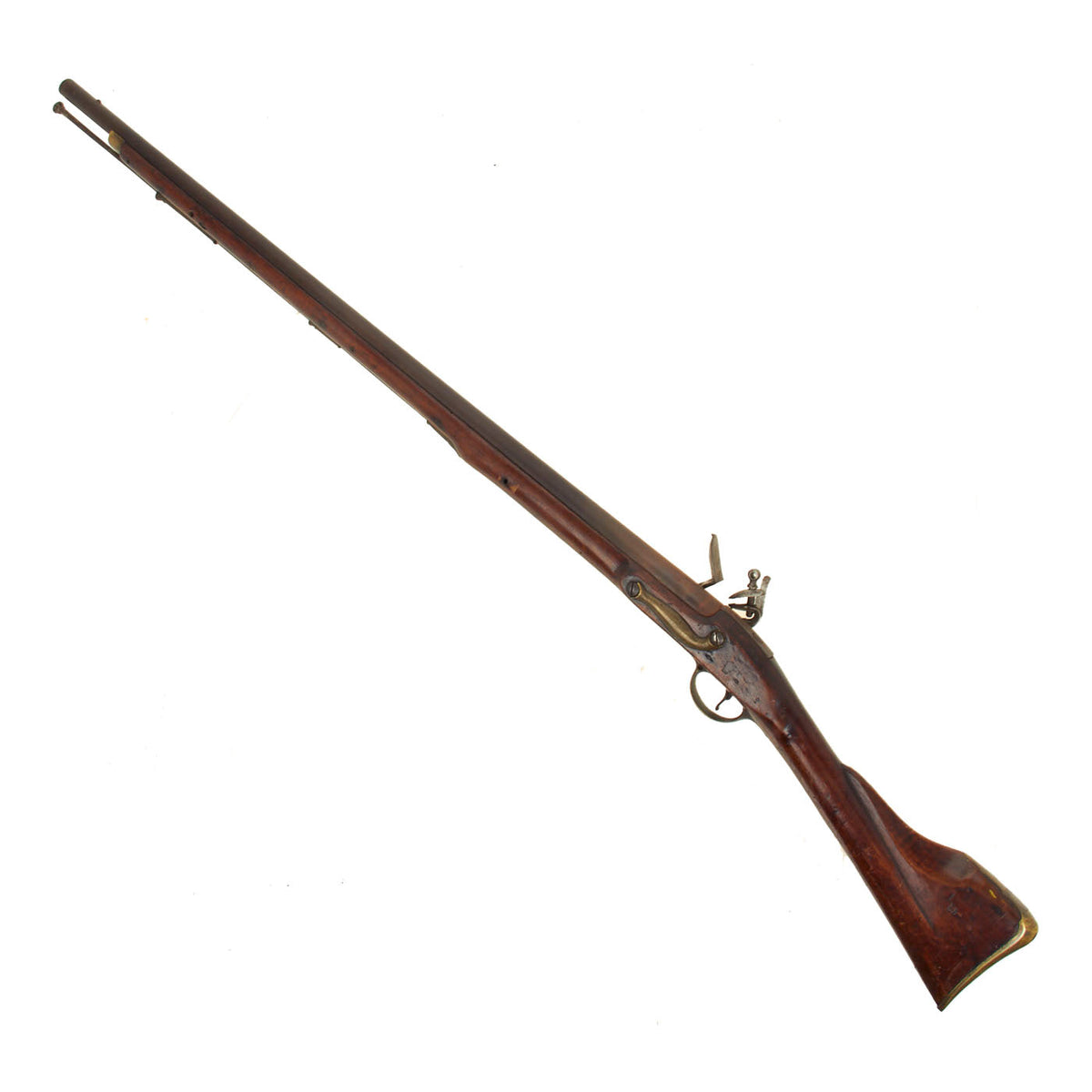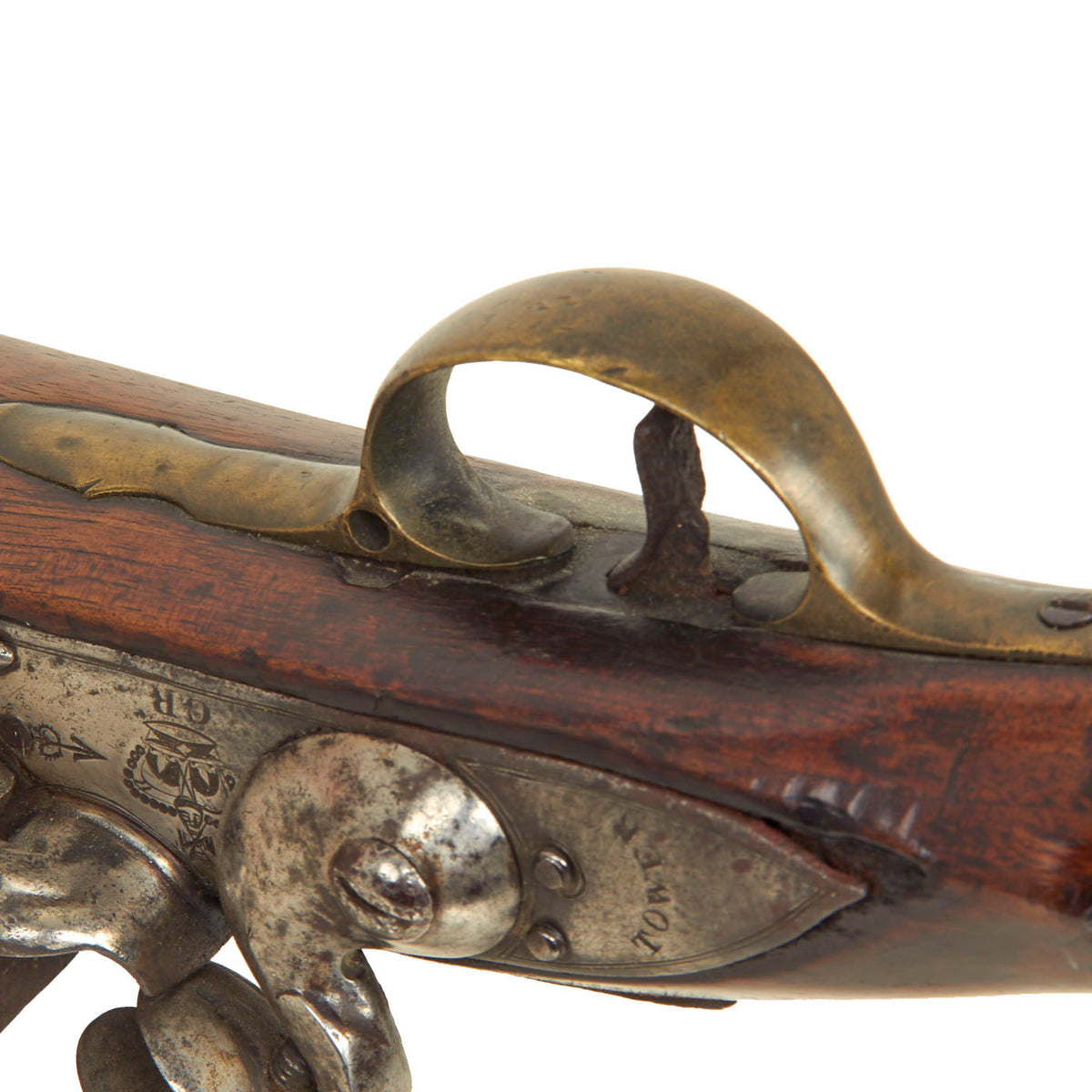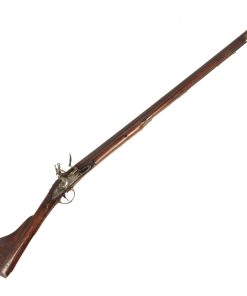Original British Napoleonic Tower Marked 3rd Model P-1796 Brown Bess Flintlock Musket Marked to The King’s German Legion 5th Battalion Original Items
$ 2.795,00 $ 698,75
Original Item: Only One Available. This is a fine example of a British Third Model Brown Bess, with the 39″ barrel adopted in 1796. Also known as the “India Pattern”, it was the standard Musket of the line during 1815, the time of the Battle of Waterloo. It is marked on the top of the barrel with K. G. L. 5’TH BAT’N, for the KING’S GERMAN LEGION, 5TH BATTALION. This musket almost certainly saw service during the Napoleonic Wars, and may have been been carried on the battlefield at Waterloo itself!
We often overlook that the British Kings of the 1700s were not English at all but were from the German State of Hanover, starting with King George I in 1714. He was followed by George II until 1760 and then the famous King George III of American Revolutionary war fame. King George III lived right through the Napoleonic Wars which ended in 1815 subsequently passed away in 1820. Consequently the British army was full of Germans and German Regiments, probably best remembered as the The King’s German Legion, a British Army unit of mostly expatriate German personnel during the period 1803–16. The Legion achieved the distinction of being the only German force to fight without interruption against the French during the Napoleonic Wars.
Having shown great heroism and service, in 1812 the K.G.L. were officially listed as BRITISH ARMY and given all privileges thereto. At the BATTLE OF WATERLOO, the 5th. Battalion of the King’s German Legion was under the command of Colonel (Oberst) Christian Friedrich Wilhelm von Ompteda, who had joined up with the K.G.L. after the Hanoverian army was dissolved. During the battle, the 5th Battalion was ordered to break square and charge the oncoming French infantry by The PRINCE of ORANGE. Colonel Von Ompteda, despite his objections to this rash move, was overruled and had the battalion break square and charge the oncoming French Infantry.
The Colonel’s objections were well founded, as the charging 5th Battalion were hit by a charge of French Cuirassiers in the rear flank. Colonel Von Ompted was killed and the whole battalion was cut to pieces. Only 19 Troopers escaped back to Allied Lines. Another long forgotten Allied disaster of the Battle of Waterloo. Details of the action are readily available on the Internet.
After the victory at Waterloo, the Electorate of Hanover was re-founded as the Kingdom of Hanover. However, the army of Hanover had been reconstituted even before the final battle, so that there were two Hanoverian armies in existence. In 1816 the legion was dissolved and some officers and men were integrated into the new Hanoverian army.
This musket apparently ended up in Germany after Waterloo, and was modified in typical German style of adding a deep cheek rest to the butt stock. It can however still be seen that it originally had a “bannister rail” butt stock, a feature that was basically done away with after 1807. The musket has a full 39″ regulation length, .75″ smoothbore iron barrel, which bears British Proof Marks, which are still fully clear. These include a faint CROWN / GR, the royal cypher, and the CROWN / CROSSED SCEPTERS of Thomas Ketland of St Catherine St, Weaman Row Birmingham, who worked 1766 to 1810. This was later adopted as the mark of the Birmingham Proofhouse. It’s somewhat rare to see the proofs still visible, as they are in a high wear area.
The lock plate is full marked with CROWN / G.R. mid lock for King George III, with TOWER across the tail. Under the flash pan is the correct CROWN / BROAD ARROW “Lock Viewer’s Mark”. The lock has a swan neck cock, indicating pre-1808 construction, so this is a rifle that was in service during the Napoleonic wars. It has all regulation brass furniture, together with correct issue iron ramrod. Shows use but remains in amazingly tight and clean condition. Action is strong and holds at half cock, firing correctly at full cock. The lock is quite clean and in great shape. The barrel has some powder burns on the right side by the lock, but is otherwise very nice.
The stock on this example is in very good shape, and the cutout cheek rest in the butt stock really adds to the charm! There is of course the usual denting and scratching from wear, expected on a musket that has seen real service. The sling swivels were unfortunately removed at some point, probably after it left military service. There are some interesting markings on the butt plate tang, which read 31. C. / No. 14, which may be a rack number, probably from when it was in British service.
A most unusual British issue Brown Bess Musket with fantastic research potential! Rare and ready to display!
Specifications:
Years of Manufacture: Circa 1796-1805
Caliber: .75″ Musket
Ammunition Type: Lead Ball & Powder
Barrel Length: 39 inches
Overall Length: 55.5 inches
Action: Flintlock
Feed System: Muzzle-Loaded
NOTE: International orders of antique firearms MUST be shipped using UPS WW Services (courier). USPS Priority Mail international will not accept these. International customers should always consult their country’s antique gun laws prior to ordering.
Fast Shipping with Professional Packaging
Thanks to our longstanding association with UPS FedEx DHL, and other major international carriers, we are able to provide a range of shipping options. Our warehouse staff is expertly trained and will wrap your products according to our exact and precise specifications. Prior to shipping, your goods will be thoroughly examined and securely secured. We ship to thousands clients each day across multiple countries. This shows how we're dedicated to be the largest retailer on the internet. Warehouses and distribution centres can be located throughout Europe as well as the USA.
Note: Orders with more than one item will be assigned a processing date depending on the item.
Before shipping before shipping, we'll conduct a thorough inspection of the items you have ordered. Today, the majority of orders will be delivered within 48 hours. The delivery time will be between 3-7 days.
Returns
The stock is dynamic and we cannot completely manage it because multiple stakeholders are involved, including our factory and warehouse. So the actual stock may alter at any time. It's possible that you may not receive your order once the order has been made.
Our policy is valid for a period of 30 days. If you don't receive the product within 30 days, we are not able to issue a refund or an exchange.
You can only return an item if it is unused and in the same state as the day you received it. You must have the item in its original packaging.
Related products
Uncategorized
Uncategorized
Uncategorized
Uncategorized
Armored Burgonet Helmet & Polearm from Scottish Castle Leith Hall Circa 1700 Original Items
Uncategorized
Uncategorized
Uncategorized
Uncategorized
Uncategorized
Uncategorized
Uncategorized
Uncategorized
Uncategorized
Uncategorized
Uncategorized
Armoured Fighting Vehicles of the World: AFVs of World War One (Hardcover Book) New Made Items
Uncategorized
Uncategorized
Uncategorized
Uncategorized
Uncategorized












































































